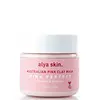What's inside
What's inside
 Key Ingredients
Key Ingredients

 Benefits
Benefits

 Concerns
Concerns

 Ingredients Side-by-side
Ingredients Side-by-side

Kaolin
AbrasiveWater
Skin ConditioningBentonite
AbsorbentAloe Barbadensis Leaf Juice
Skin ConditioningTerminalia Ferdinandiana Fruit Extract
AntioxidantCentipeda Cunninghamii Extract
Skin ConditioningGlycyrrhiza Glabra Root Extract
BleachingRetinyl Palmitate
Skin ConditioningTocopheryl Acetate
AntioxidantUndaria Pinnatifida Extract
Skin ConditioningHamamelis Virginiana Bark/Twig Extract
AstringentPunica Granatum Sterols
Skin ConditioningGarcinia Mangostana Fruit Extract
Skin ConditioningRosmarinus Officinalis Leaf Extract
AntimicrobialPhenoxyethanol
PreservativeDehydroacetic Acid
PreservativeLactic Acid
BufferingCI 77491
Cosmetic ColorantParfum
MaskingGlycerin
HumectantBenzyl Alcohol
PerfumingLimonene
PerfumingKaolin, Water, Bentonite, Aloe Barbadensis Leaf Juice, Terminalia Ferdinandiana Fruit Extract, Centipeda Cunninghamii Extract, Glycyrrhiza Glabra Root Extract, Retinyl Palmitate, Tocopheryl Acetate, Undaria Pinnatifida Extract, Hamamelis Virginiana Bark/Twig Extract, Punica Granatum Sterols, Garcinia Mangostana Fruit Extract, Rosmarinus Officinalis Leaf Extract, Phenoxyethanol, Dehydroacetic Acid, Lactic Acid, CI 77491, Parfum, Glycerin, Benzyl Alcohol, Limonene
Kaolin
AbrasiveWater
Skin ConditioningBentonite
AbsorbentHamamelis Virginiana Extract
AntiseborrhoeicAloe Barbadensis Extract
Skin ConditioningPunica Granatum Extract
AstringentGlycyrrhiza Inflata Root Extract
Skin ConditioningIsododecane
EmollientAscorbic Acid
AntioxidantPropylene Glycol
HumectantTocopherol
AntioxidantScutellaria Baicalensis Root Extract
AstringentSophora Flavescens Root Extract
AntioxidantCitrus Reticulata Fruit Extract
Skin ProtectingRosa Rugosa Flower Oil
MaskingGlyceryl Stearate
EmollientPEG-120 Glyceryl Stearate
Rosmarinus Officinalis Leaf Oil
MaskingPolysorbate 80
EmulsifyingXanthan Gum
EmulsifyingAllantoin
Skin ConditioningAcrylates Copolymer
Phenoxyethanol
PreservativeEthylhexylglycerin
Skin ConditioningCI 77491
Cosmetic ColorantKaolin, Water, Bentonite, Hamamelis Virginiana Extract, Aloe Barbadensis Extract, Punica Granatum Extract, Glycyrrhiza Inflata Root Extract, Isododecane, Ascorbic Acid, Propylene Glycol, Tocopherol, Scutellaria Baicalensis Root Extract, Sophora Flavescens Root Extract, Citrus Reticulata Fruit Extract, Rosa Rugosa Flower Oil, Glyceryl Stearate, PEG-120 Glyceryl Stearate, Rosmarinus Officinalis Leaf Oil, Polysorbate 80, Xanthan Gum, Allantoin, Acrylates Copolymer, Phenoxyethanol, Ethylhexylglycerin, CI 77491
Ingredients Explained
These ingredients are found in both products.
Ingredients higher up in an ingredient list are typically present in a larger amount.
Bentonite is an aluminium phyllosilicate clay with great absorbent properties. The name 'bentonite' comes from the area where the largest source is found: Fort Benton, Wyoming.
As a clay, bentonite is often used to absorb excess oil and provide exfoliation. It has also been shown to have some antibacterial and anti-inflammatory properties. Studies show bentonite was effective at calming dermatitis from poison ivy and in diaper dermatitis of infants. Bentonite has also been shown to act as a barrier against toxic compounds on your skin.
Sunscreens containing bentonite display higher water resistance and stay on the skin for much longer. The sunscreens containing bentonite also show higher potency and UV light absorbtion.
Bentonite is naturally created from volcanic ash and several natural weathering/hydrothermal processes.
A common usage of bentonite is removing excess protein from white wines. Bentonite contains a property of being able to absorb large amounts of protein from aqueous solutions.
Phyllosilicate clay has a structure formed by sheets.
Learn more about BentoniteCi 77491 is also hydrated iron III oxide. It's sole purpose is to give a red/pink hue to products.
Iron III oxides are classified as inorganic chemicals for coloring.
Synthetically created Ci 77491 is considered safer than those naturally found. This is because the synthetically created version may contain less impurities. Iron oxides are generally non-toxic and non-allergenic.
Learn more about CI 77491Kaolin is a clay. It is used for oil control and to help minimize pores. Like other clays, kaolin has the ability to absorb excess sebum or oil. This can help clean out pores and mattify the skin.
Some types of kaolin may have exfoliating properties. When water is added to kaolin, it becomes a paste with small abrasive particles.
Most kaolin is a white color, but may be pink/orange/red depending on where it comes from.
The name 'kaolin' comes from a Chinese village named 'Gaoling'. Kaolin clay comes from rocks rich in kaolinite. Kaolinite, the mineral, has a silicate layered structure. Kaolinite is formed from chemical weathering of aluminum siilicate minerals.
Besides skincare, kaolin is commonly used to make glossy paper, in ceramics, toothpaste, and as medicine to soothe stomach issues.
Learn more about KaolinPhenoxyethanol is a preservative that has germicide, antimicrobial, and aromatic properties. Studies show that phenoxyethanol can prevent microbial growth. By itself, it has a scent that is similar to that of a rose.
It's often used in formulations along with Caprylyl Glycol to preserve the shelf life of products.
Water. It's the most common cosmetic ingredient of all. You'll usually see it at the top of ingredient lists, meaning that it makes up the largest part of the product.
So why is it so popular? Water most often acts as a solvent - this means that it helps dissolve other ingredients into the formulation.
You'll also recognize water as that liquid we all need to stay alive. If you see this, drink a glass of water. Stay hydrated!
Learn more about Water